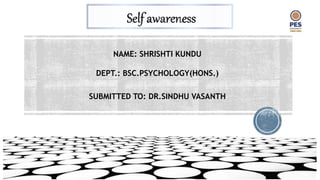
Psychological processes_psychology_undergraduate
- 1. NAME: SHRISHTI KUNDU DEPT.: BSC.PSYCHOLOGY(HONS.) SUBMITTED TO: DR.SINDHU VASANTH
- 2. SELF AWARENESS Self-awareness refers to the conscious knowledge of one’s own character, emotions, desires, and motivations. • It is a key component of emotional intelligence theory and, in psychology, the two concepts are often studies as co-dependent and intricately linked. • Being self-aware can refer to the ability to be conscious of both your own behaviors and how others perceive them. For example, ability to identify and name your current emotions and identify how others are reacting to your behaviors are both examples of self-awareness.
- 3. SELF AWARENESS AND ITS TYPES •Internal self-awareness: refers to understanding your own emotions and how they affect your thoughts and actions. This is an inherent introspective task and an intrapersonal skill. •External self-awareness: refers to understanding how others perceive your thoughts and actions. In other words, it’s the ability to be aware of your situatedness within social contexts and a key interpersonal skill.
- 4. Based on these two types of self-awareness, there are four ‘self-awareness archetypes’.
- 5. •Introspectors: Introspectors have high internal self-awareness, meaning they are very much aware of their own emotions. However, they’re often unaware of how others perceive them (low external self-awareness). They often don’t seek out feedback from others, which can limit their self-growth and lead to plenty of blindspots. •Aware: The ‘aware’ archetype is the idealized model because it represents people with very high emotional intelligence. These people are both internally and externally self-aware, meaning they will both self-reflect regularly and seek out external information and feedback to help broaden their perspectives and address blindspots. •Seekers: Seekers don’t think much about themselves, their emotions, thoughts, or identities. They also aren’t aware of how others perceive them. As a result, they’re often frustrated by their lack of progress (especially in terms of networking and relationships). •Pleasers: Pleasers tend to be more focused on and concerned about how others perceive them than their own self-perception. By focusing too much on pleasing others, they often make decisions that aren’t in their own best interests, such as by saying ‘yes’ to too many collaborations, leading them to becoming burned-out! TERMINOLOGY
- 6. The Benefits Of Self-Awareness The benefits of self-awareness are profound and far-reaching, profoundly impacting various aspects of life. •Relationships and Interpersonal Skills: Having high internal and external self-awareness means you’re tuned not just into your own actions and emotions but also those of the people around you. This can help predict and respond appropriately to others’ behaviors, needs, and emotions, strengthening and deepening your relationships. •Personal and professional growth: By understanding your strengths, weaknesses, core values, and areas that need improvement, you can develop strategies to bolster your skills and address areas of weakness. In a professional context, this might translate to choosing projects that align with your strengths or opting for upskilling in areas where you’re not as confident. •Stress management: Recognizing your emotional and physical reactions to stress can help you develop effective coping mechanisms. Whether it’s understanding that a walk outdoors can calm your mind or realizing that speaking about your challenges helps relieve stress, these strategies are borne out of self-awareness. •Emotional health: Self-awareness lets you better understand and manage your own emotions, leading to improved psychological well-being. Take, for example, developing clarity about sleep patterns, foods, exercise patterns, or actions that affect your mood. This self-awareness can help you to make life decisions that can manage your emotions more effectively. Decoding your emotional responses leads to better resilience and overall emotional health.
- 7. Low internal self awareness Low internal self-awareness denotes a lack of understanding or consciousness about one’s own emotions, thoughts, desires, and values, as well as how these influence one’s behavior. EXAMPLES • Overlooking preferred learning styles and methods. • Underestimating the intensity and range of your emotions. • Ignoring personal needs and neglecting self- care. • Missing the recognition of personal growth over time. Low external self awareness Low external self-awareness refers to a deficit in understanding how one is seen by others and how one’s behavior impacts them. EXAMPLES Failing to recognize how your social media presence impacts others. Overlooking student feedback or response to teaching methods. Disregarding the impact of your sense of humor on others. Ignoring how your behavior or actions alter team dynamics.
- 8. High internal self awareness High internal self-awareness involves the understanding of one’s emotions, thoughts, and values, and how they affect behavior. EXAMPLES • Being clear about your long-term goals and what you want in life. • Recognizing unproductive habits and actively trying to change them. • Acknowledging your core personal beliefs and how they shape your worldview. • Being aware of your emotional triggers and learning to control them. Low external self awareness High external self-awareness comprises the understanding of how one is perceived by others, recognizing others’ perspectives, and adapting to different interactions or situations. EXAMPLES Adjusting one’s behavior to align with cultural norms or social expectations. Comprehending how effective your persuasion methods are in changing others’ opinions. Being considerate of others’ needs while expressing your own. Actively seeking feedback from peers, friends, or family.